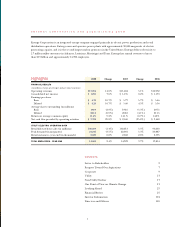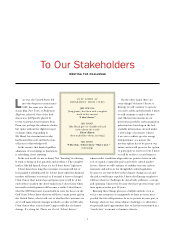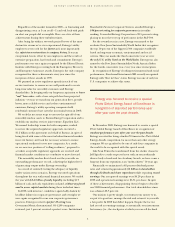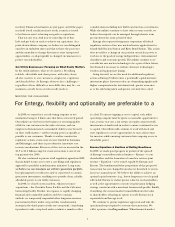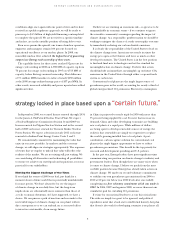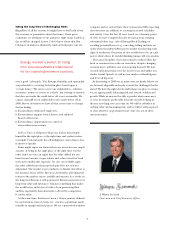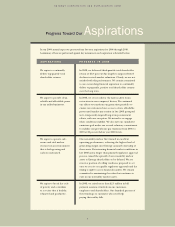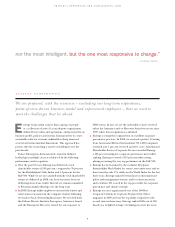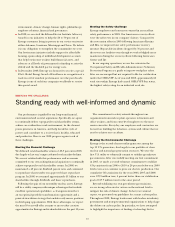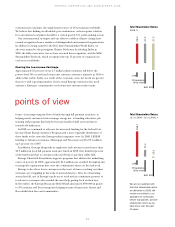Entergy 2008 Annual Report Download - page 7
Download and view the complete annual report
Please find page 7 of the 2008 Entergy annual report below. You can navigate through the pages in the report by either clicking on the pages listed below, or by using the keyword search tool below to find specific information within the annual report.5
conditions align once again with our point of view and we have
received acceptable regulatory approvals, we will be ready to
pursue up to $4.5 billion of high-yield financing contemplated
to complete the spin-off. We are not tied to a specific timeline
and in fact, are in the enviable position of being able to wait.
Even as we pursue the spin-off, our teams of nuclear operators,
engineers and managers remain 100 percent focused on
operational excellence at our nuclear plants. In 2008, our
non-utility nuclear fleet achieved the highest level of generating
output since Entergy took ownership of these assets.
The capability factor for these assets reached 92 percent for
outage cycles ending in 2008 on 4,998 MW of capacity, up from
76 percent for outage cycles ending in 1997 on 4,753 MW of
capacity, before Entergy assumed ownership. That difference
of 7.1 million MWh translates to value of nearly $250 million
at the 2008 average realized energy price of $57 per MWh. In
other words, increased reliability and power uprates have added
significant value.
In September 2008, we secured license renewal through 2034
for the James A. FitzPatrick Nuclear Power Plant. We expect
a Nuclear Regulatory Commission decision by mid-2009 on
license renewal for Pilgrim Nuclear Station and in the second
half of 2009 on license renewal for Vermont Yankee Nuclear
Power Station. We expect a decision in early 2011 on license
renewals for Indian Point Energy Center Units 2 and 3.
We remain firmly committed to maximizing the value that
exists in our asset portfolio. As markets and the economy
change, we will align our strategies appropriately. The sequence
of events that we employ to unlock that value will reflect the
realities of the market. We are not sitting still; just waiting. We
are considering all alternatives and exhausting all possibilities
to ensure we achieve our stated goals and aspirations as soon as
practical for our stakeholders.
Meeting the Biggest Challenge of Our Times
If you think the events of 2008 were bad, just think for a
moment about a future world that is potentially uninhabitable
for some species. We don’t always feel or see the impact
of climate change in our daily lives, but the long-term
implications are substantially more ominous than those of
a cyclic economic downturn. As I have suggested, we have a
choice. We can pursue a path of inaction and succumb to the
irreversible impact of climate change on our planet with its
dire consequences or we can embark on a concerted effort
to invest in a sustainable, clean energy future.
I believe we are running an enormous risk – so great as to be
unquantifiable in economic terms – if we continue to ignore
the scientific community’s warnings regarding the impact of
climate change. As a responsible, prudent nation we should be
working to mitigate the chance of a truly catastrophic outcome
by immediately reducing our carbon dioxide emissions.
It is clearly the responsibility of the United States to lead on
the climate change issue. Americans use nearly six times the
energy per capita as the Chinese and twice as much as other
developed countries. The United States is in the best position
to find and fund new technologies and set the standard for
meaningful action on climate change. I believe that action
should include an immediate, meaningful cap on future CO2
emissions in the United States through either a cap-and-trade
system or carbon tax.
Conventional coal plants are the single largest source of
greenhouse gases in the world, accounting for nearly a third of
global energy-related CO2 emissions. Electricity consumption
in China is projected to nearly triple by 2030 with more than
75 percent being supplied by coal. To meet that increase in
demand, China and other developing economies are building
new coal plants at a rapid pace. While millions of dollars
are being spent to develop renewable sources of energy, the
reality is that renewables are simply too expensive to replace
the world’s growing installed base of coal plants. A post-
combustion, carbon-capture solution for conventional coal
plants is the single biggest opportunity we have to reduce
greenhouse gas emissions. This should be the top priority for
research and development spending and U.S. policies.
In the past year, Entergy leaders have spent significant time
communicating our position on climate change to industry and
government leaders. Even though there are many voices when
it comes to climate change, I believe we speak from the most
credible position because Entergy has already taken action on
climate change. We made our second voluntary commitment
to stabilize our own greenhouse gas emissions from 2006 to
2010 at 20 percent below year 2000 levels after successfully
completing our first voluntary commitment which was made in
2001. In 2006, 2007 and again in 2008, we more than met our
cumulative goal for curtailing CO2 emissions.
It’s time for our national leaders to act on this critical issue.
The risks are simply too great to be ignored, and political
expedience must take a back seat to intellectual honesty. Any plan
that doesn’t also work for developing countries is no plan at all.
ENTERGY CORPORATION AND SUBSIDIARIES 2008
strategy locked in place based upon a “certain future.”



